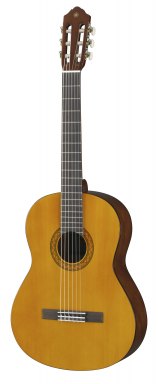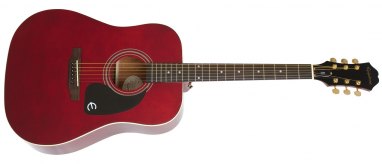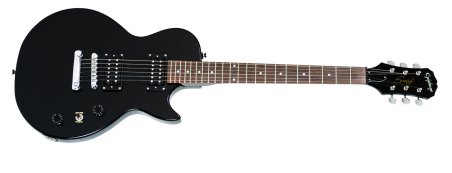TYPES OF GUITARS: WHICH KIND SHOULD YOU BUY?
1. NYLON STRING ACOUSTIC GUITAR
A lot of people begin with a nylon string acoustic, often called a classical guitar. They’re reasonably priced at beginners level (don’t go too cheap), the design has a wide fret board to accommodate your inexperienced fingers and the nylon strings are easier on your aching fingertips. You have to agree, they can sound kind of dull unless that dream of yours is of becoming a famous, classical guitarist like John Williams — certainly not a bad thing. So nylon string acoustics are great to learn with, but there’s a risk you’ll want something more pretty quickly.
This is Yamaha’s C40II classical guitar, an inexpensive nylon-strung guitar that’s a cut above some of Yamaha’s even cheaper models designed for schools and the like. Many companies offer a line of low-priced, very basic designs tailored for education facilities. Don’t go that far down the price pecking order. The C40II for $140 USD on Amazon is a good compromise. Please do yourself a favor and get the $13.58 two-year protection plan!
2. STEEL STRING ACOUSTIC GUITAR
Better known simply as an acoustic guitar, the “steel” strings (they come in all kinds of construction, not just steel) are louder and brighter, and a much more versatile instrument to play. Folk, rock, jazz — acoustic guitars have it all covered. Those steel strings also chew the ends off your fingers until eventually you develop hard calluses on the tips — very handy for plucking boiled eggs out of the saucepan.
The Epiphone DR-100 is a traditional design of steel string, acoustic guitar, often called a dreadnought with this body shape. To keep the price down you don’t get pick-ups or high quality machine heads, but it’s still an Epiphone for about $100 USD.
A good acoustic guitar is a joy to play and you can learn almost every style of modern playing on one. So it sounds like the obvious guitar to start with, right? Sure, but…
3. ELECTRIC GUITAR
Electric guitars are fantastic fun — as long as you can hear them (and your neighbors can’t). That’s one drawback. Some kind of amplification is needed or software with a decent audio interface and headphones. It has to be said, too, that electric guitars are in one way much easier to play with their low string action. At the same time, the narrow fret boards require a higher level of skill to allow precise fingering and avoid inadvertently muting some strings. But hey, your dream is to be an electric guitar playing rock god, so shouldn’t you learn with one? I reckon there’s a better alternative.
The Fender Stratocaster Squier is possibly the most recognizable shape in electric guitar history. The Fender Stratocaster design is mimicked by manufacturers all over the world. Fender produces its own line of budget “Strats” called the Squier series. If you want to start with an electric guitar, chances are you’ll buy something like this for around $130 USD.
It looks like a Gibson. but it’s another Epiphone — the Epiphone Les Paul Special II. This is the other iconic shape in electric guitars, the Gibson Les Paul, and Epiphone make the budget-priced version with this one listed at $170. In another blog we’ll explain the primary differences between Gibson and Fender guitars. For now, just know it’s like an Apple versus Windows kind of debate. Really.



